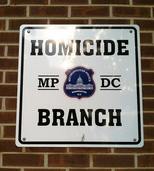Homicide Watch will survive. Can MPD also support it more?
Homicide Watch DC, a website devoted to following murders in DC through to arrests and convictions, won’t have to shut down. Last night, it successfully reached its $40,000 goal on Kickstarter to continue operating and turn into a paid student reporting lab.
Development, housing, employment, education, and transportation often dominate the local news cycle, while crime, poverty, and murder are often overlooked. For the latter, Homicide Watch has emerged, in the less than two full years it has been operational, as a destination and point of connectivity for concerned residents, journalists, and friends and family members of the victim. As academics have taken notice, so have investigators, who monitor the site for the slightest hint that may lead to a break in the case.
Laura Amico, who co-founded the site with her husband, was recently awarded a journalism fellowship at Harvard. She planned to license Homicide Watch to a “local news organization that would have taken over” its operation, but at the last minute, the plan did not materialize and Homicide Watch faced the specter of shutting down.
Amico opened a Kickstarter account 3 weeks ago to fund turning the site into a lab for student journalists, who would each follow some of the homicides in exchange for compensation. As of last night, the campaign passed its $40,000 goal as more than 1,000 backers offered over $46,000 in support.
Homicide takes its toll on families
Murder affects DC neighborhoods very differently. West of Rock Creek Park, murder has occurred rarely more than once or twice a year over the past decade, yet neighborhoods like Barry Farm and corners like 6th and Chesapeake Streets SE in Washington Highlands, on occasion, are touched multiple times a week. More than 30 homicides this year remain unsolved, nearly 40 from last year, and close to 100 in each of 2010 and 2009. DC has close to 250 unsolved homicides in the past 4 years.

Street memorial for Sirrocco Delonte Johnson. Photo by Lloyd Wolf.
For many still-unsolved cases, the victim has an individual page on Homicide Watch lists the phone numbers of the active detectives, as with Sirrocco Delonte Johnson’s cold case from April.
In an age where even prisoners behind jail walls can access social media at all hours, we should support an online resource like Homicide Watch to help solve every open murder case. For Ms. Ella Carey, mother of 19-year old Anthony Reginald Ford, Jr. who was slain on 58th Street SE in the summer of 2009, the webpage for her son’s street memorial on Washington’s Other Monuments not only helps her grieve but lets “those cowards [who] took my son away from me” know the law will not rest until justice is served.
”[Homicide Watch] provides thorough, accurate up-to-date information on every aspect of the issue, far better than any other media or government source,” says photography artist Lloyd Wolf, who has documented nearly 500 street memorials in the Washington, DC metropolitan area over the past decade. As with Homicide Watch D.C., Wolf’s site, Washington’s Other Monuments, has become a virtual destination for mourners to collectively grieve and share their memories. “Most critically perhaps, Homicide Watch has created a meaningful forum for the families and friends of area homicide victims to connect, share, and remember.”
“Homicide Watch is a very important resource for everyone,” says Kristopher Baumann, head of the DC police union. “It benefits the public, the police, and the families of victims. The more sunlight and focus on the government and its processes the better.”
Can MPD help as well?
Despite its Kickstarter success, Homicide Watch has work ahead to transform itself from a personal project by the Amicos to a student-driven news operation. The Metropolitan Police Department (MPD), which benefits from public attention on crime and the leads that can come from the press, should consider finding ways to facilitate the important work of publicly documenting every murder in the city from crime to conviction.
For current unsolved deaths and murders, MPD maintains a webpage with PDFs of reward posters organized year by year. The oldest current case is Christina Burke, aka Christine Baynard, from 1962.
MPD could work with Homicide Watch to better organize and disseminate this information, such as by embedding Homicide Watch’s better-organized pages on the MPD site or linking to it. It could also work with Homicide Watch to collect leads and information about murders and pass them on to the appropriate detectives.
MPD could do monthly or quarterly Q&As on Homicide Watch with officers in the homicide branch. They could discuss recent closed and open cases, talk about efforts to close cold cases, how to be in touch with officers, and make a push for better citizen cooperation. There could even be guest columns from members of MPD, in addition to the testimonials from mourners the site has now.
In the past, MPD has had law students help investigate cold cases. This could be integrated with Homicide Watch, with public information they find posted on Homicide Watch. And, of course, the most direct way MPD could help Homicide Watch is through funding.
If Homicide Watch survives and thrives, all of DC will be better off, from the families of victims to the police trying to close years-old cases. Fortunately, the Kickstarter campaign’s success has given this valuable resource a strong hope of making it in the long run.

